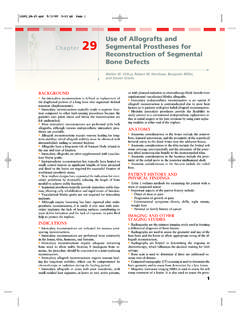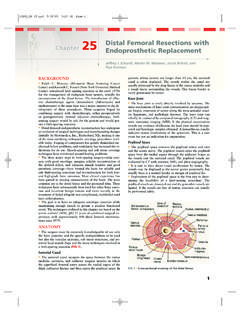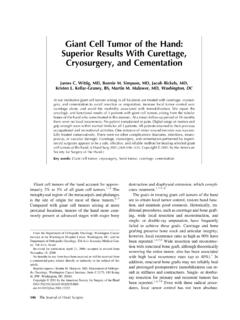Transcription of 20 Posterior Flap Hemipelvectomy - Sarcoma.org
1 Malawer Chapter 20 22/02/2001 08:40 Page 319. 20. Posterior flap Hemipelvectomy Martin Malawer and Robert Henshaw OVERVIEW. In spite of increasingly effective chemotherapy and advances in limb-sparing surgery around the pelvis and hip (see Chapter 10), hindquarter amputation ( Hemipelvectomy ) often remains the optimal surgical treatment for primary tumors of the upper thigh, hip, or pelvis. Hemipelvectomy may also be life-saving for patients with massive pelvic trauma or uncontrollable sepsis of the lower extremity, and it can provide significant palliation of uncontrollable metastatic lesions of the 3 An intimate knowledge of the pelvic anatomy (Figures ,B) and a systematic approach to the surgical procedure are required to minimize the intraoperative and postoperative morbidity associated with this demanding procedure.
2 The patient is placed in a modified semi-supine position. Incision of the abdominal wall and retroperitoneal dissection of the iliac vessels are performed first. The common iliac, external iliac, or internal iliac (hypogastric). vessels are selectively ligated according to the type of Hemipelvectomy to be performed. Exposure of the pubis, bladder neck, and urethra permits sectioning of the symphysis pubis. The iliac wing, sacroiliac joint, or sacrum is then exposed and divided to complete the amputation. Division of the lumbosacral plexus at the level of the sacrum or pelvis is accomplished at the same time.
3 A fasciocutaneous or a myocutaneous flap (involving the gluteus maximus for Posterior flaps or the anterior compartment of the thigh for anterior flaps) is then completed. Flexion and adduction/abduction of the hip then allows the surgeon to divide the muscles and ligaments of the pelvic floor and complete the amputation. The wound is closed by rotating and suturing the prepared myocutaneous flap to the abdominal wall and flank. Maximizing the patient's functional outcome requires the combined skills of an experienced multidisciplinary team of physical, occupational, and rehabilitative therapists.
4 Malawer Chapter 20 22/02/2001 08:41 Page 320. 320 Musculoskeletal Cancer Surgery INTRODUCTION advent of limb-sparing pelvic resections has necessitated a distinction between internal and external Early descriptions of the surgical technique of Hemipelvectomy , depending on whether preservation Hemipelvectomy emphasized the importance of careful of the ipsilateral limb is performed. Confusion caused selection of patients and immediate replacement of by the term internal Hemipelvectomy can be avoided blood 18 Other, later technical descriptions of this by use of a standardized classification for pelvic procedure have been 25 Recent reports of resection (see Chapter 26).
5 Series of Hemipelvectomy patients have shown this Sugarbaker28,29 and others30 36 have shown the utility procedure to have a low mortality rate and to offer an of a myocutaneous pedicle flap based upon the femoral acceptable survival in carefully selected ,26. vessels and anterior compartment of the thigh for Quality-of-life studies suggest that long-term morbidity closure of the wound in patients with tumor involving in patients who have undergone this radical ampu- the Posterior buttock structures. This procedure has tation is not greater than that experienced by patients been termed an anterior flap Hemipelvectomy , to who have undergone other cancer distinguish it from the more common Posterior flap Hemipelvectomy .
6 Anterior flap Hemipelvectomy is indicated for tumors that involve the buttock and for CLASSIFICATION. selected patients in whom a well-vascularized flap is Current terminology for major amputations through required for coverage. the pelvis is overly simplistic and consequently There are subtypes of the Posterior flap hemipelvec- confusing. The terms hindquarter amputation and tomy (Figure ). The term classic Hemipelvectomy . Hemipelvectomy are often used interchangeably to is used to refer to amputation of the pelvic ring via refer to any amputation performed through the pelvis. disarticulation of the pubic symphysis and the Older terms used to describe this same procedure include sacroiliac joint (SI), division of the common iliac vessels, interpelviabdominal4 or interinnomino-abdominal5 and closure with a Posterior fasciocutaneous flap .
7 Amputation to describe this same procedure. The Classic Hemipelvectomy is typically necessary for large A B Retroperitoneal space Psoas m. Femoral nerve (under psoas muscle). Ureter (retracted on Iliacus m. peritoneal reflection Bladder Inguinal ligament Spermatic cord (divided) (retracted). Femoral nerve artery and vein Figure (A) Anatomy of the pelvis. (B) Schematic diagram of the retroperitoneal space and the significant C Extended anatomic structures. (C) Schematic demonstrating the Standard various types of Hemipelvectomy . Modified ( conservative'). Malawer Chapter 20 22/02/2001 08:41 Page 321.)
8 Posterior flap Hemipelvectomy 321. tumors that arise within the pelvis. Modified hemi- circumstances is dictated by the anatomic location of pelvectomy refers to a procedure that preserves the the tumor and the expected defect to be created by the hypogastric (internal iliac) vessels and the inferior resection. For example, a Posterior tumor involving the gluteal vessels supplying the gluteus maximus, buttock and sciatic nerve that cannot be resected by a permitting creation of a vascularized myocutaneous buttockectomy can be removed and closed with a Posterior flap for wound closure. This term also vascularized pedicle anterior flap Hemipelvectomy .
9 Describes any and all variations from the classic operation, including resection through the iliac wing or contralateral pubic rami. Modified Hemipelvectomy is most commonly performed for tumors involving the thigh and/or hip, when a limb-sparing alternative is contraindicated. Extended Hemipelvectomy refers to a resection of the hemipelvis through the sacral alar and neural foramina, thereby extending the margin for tumors that approach or involve the SI joint. Regardless of the type of flap created for closure, the term compound Hemipelvectomy is used to describe resection of contiguous visceral structures such as bladder, rectum, prostate, or uterus.
10 (Patients suspected of having tumor extending into viscera, or an extremely large tumor filling the pelvic fossa, can be approached through an intraperitoneal incision.). INDICATIONS. The advent of limb-sparing procedures combined with Figure CT scan showing a large secondary chondro- effective chemotherapy and/or radiation therapy has sarcoma (arrow) arising from the left proximal femur in a greatly reduced the need to perform radical amputa- patient with multiple hereditary osteochondromatosis. Note tions of the lower extremity. Increasing experience with the gluteus maximus (G) was completely free of tumor.












